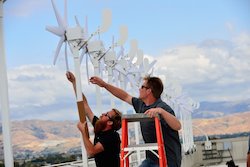Intel is participating in a unique pilot wind power project. The company is installing 58 micro-turbines on the roof to help renewably power their building. According to Marty Sedler, director of global utilities & infrastructure for Intel, the project came about due to their ongoing efforts to find more sustainable ways to use technology. This is why, he said, Intel began piloting one of the world’s largest operating rooftop arrays of wind micro-turbines on the roof of its worldwide headquarters in Santa Clara, California.

Rendering of the planned installation of 58 Wind Micro-Turbines on the rooftop of Intel’s global headquarters building in Santa Clara, California. The installation is underway and will be complete in May 2015. IMAGE SOURCE: JLM Energy, Inc.
Sedler explained that the micro-turbines are a proof-of-concept project, in which Intel hopes to collect data that could help the company better support green power applications and identify ways to continue evolving its sustainability programs. Intel also hopes the project will inspire other companies and electric users to consider creative new options to conserve energy.
Many companies, such as Intel, are not in a position to install full-scale wind turbines on their property. This is why the company partnered with JLM Energy, a Rocklin, California-based company that built and installed the micro-turbines. Sedler said each micro-turbine is between 6 and 7 feet tall and weighs approximately 30 lbs. The model of micro-turbine that Intel is using is the smallest design available for commercial buildings and is considered the most efficient turbine in its size class. Due to their small size, the micro-turbines are versatile in their potential uses and applications, said Sedler.
Each micro-turbine generates approximately 65 kWh. The array was sized to provide the electricity required for the lighting and general operation of Intel’s Executive Briefing Center. Sedler explained that since the micro-turbines need no fuel other than wind, they produce green power at no additional cost. For every kWh of green electricity the micro-turbines produce, Intel will require one fewer kWh of grid power, therefore reducing the need for power sources that produce much higher levels of greenhouse gas (GHG) emissions.

Located on the rooftop of Intel’s headquarters Robert Noyce Building in Santa Clara, California, the company is installing a total of 58 micro turbines as part of a pilot wind power project.
When Sedler was asked what the next steps for Intel might be if the pilot project proves successful, he explained, “As a proof-of-concept project, the pilot will allow Intel to collect important data about the feasibility of small-scale wind application for power generation and how to optimize future installations, which will help the company better support green power applications and identify ways to continue evolving its sustainability programs.”
“Intel plans to share the data with Silicon Valley Power, a local utility, and may also share the data with other companies, the wind power industry, NGOs and any additional parties with an interest in driving the adoption of various green power technologies,” added Sedler.
Sedler also hopes the visibility of the micro-turbines will help change the way people think about renewable energy and demonstrate the possibilities of green power technologies. Intel’s micro-turbine array is visible from Mission College Boulevard, on which more than 28,000 vehicles pass Intel’s headquarters every day. As these micro-turbines are small and compact enough to be a viable option for homeowners and small businesses, Intel hopes they will inspire other companies, industry peers and electric users to consider creative new options to conserve energy.

Intel CEO Brian Krzanich on the roof of Intel’s headquarters Robert Noyce Building checking out the company’s new wind microturbines. Intel is installing a total of 58 microturbines as part of a pilot wind power project. With Krzanich is Josh Beckwith, construction project manager with JLM Energy, the Rocklin California company that built and is installing the microturbines.
Here are some other interesting stats:
- In early 2015, Intel was recognized for the seventh consecutive year as the largest voluntary purchaser of green power in the U.S., according to the U.S. Environmental Protection Agency’s Green Power Partnership rankings. In 2014, Intel purchased enough renewable energy certificates to meet 100 percent of its U.S. electricity use for the year, amounting to approximately 3.1 billion kWh of green power.
- As of April 2015, Intel has partnered with third parties to complete 21 solar electric installations on 12 Intel campuses – in Arizona, California, Colorado, New Mexico, Oregon, India, Israel and Vietnam – collectively generating more than 12 million kWh per year of clean solar energy. Intel has installed solar hot water systems in India, Israel and Costa Rica. The India installation supplies nearly 100 percent of the hot water used at Intel’s two largest campuses in that country, saving approximately 70,000 kWh annually. Intel has also piloted wind micro-turbines and ground-source heat pumps at its site in Guadalajara, Mexico.
- Intel has achieved Leadership in Energy and Environmental Design (LEED) certification for more than 40 new and existing buildings in nine countries, with a combined total of more than 12.5 million square feet of space. Intel’s LEED certified buildings also include many of its existing manufacturing buildings, such as its first Platinum certified building, located in Israel. Since 2011, Intel’s policy has been to design all new buildings to a minimum LEED Silver certification level, and in 2014, Intel revised its policy to design all new buildings to a minimum LEED Gold certification level.
Sedler added that the micro-turbine project is just one example of Intel’s efforts to decrease their environmental footprint with renewable, clean technologies. Since 2008, Intel has invested more than $118 million in energy conservation and completed over 2,300 projects, saving more than 2.44 billion kilowatt-hours (kWh) of energy, or the equivalent approximate CO2 emissions from the electricity use of more than 153,000 average U.S. homes for one year. These investments also generated cumulative energy cost savings of $249 million for Intel through the end of 2014.

